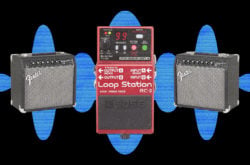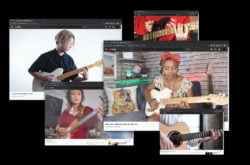Illustration: Michael Haddad
From those creating in cramped bedroom corners to those with fully-equipped studios, many music producers today began their journey as instrumentalists.
As technology has become more integrated in our everyday lives, it’s only natural for even the most old-school of instrumentalists to become increasingly curious about this mysterious ‘in-the-box’ approach to music creation.
If you’re like me (which I suspect you are if you clicked this blog title), that first instrument was guitar. My craft’s purpose was always working towards the goal of performing live. Therefore, physical gear became an obsession as soon as I memorized a pentatonic scale. I remember frequenting my favorite guitar shops, deciding between what felt like an infinite selection of picks, capos, slides, and of course, an array of stompboxes to equip myself with on my way to the stage.
This is funny today, as that definition of infinite has proved to be quite short-sighted amidst the truly overwhelming possibilities of software (DAWs, plugins, presets, and so on) combinations. Which brings me to today’s topic: With so much to decide between, how may guitarists capture their authentic, signature sound without placing undue limitations on ourselves in post?
Extrapolating further, what does it mean to have a signature sound as a producer against what live, traditionally hardware-exclusive musicianship has taught us? Here are some tips, facts, and exercises to work through when diving into this analog vs. digital debate.
How analog vs. digital effects work when recording guitar
Analog effects: Speed and variance
Analog effects utilize physical electronic components to manipulate a sound. A guitar’s sound is generated when the strings of a guitar are plucked or strummed in some way, although as we’ve already explored in our article on instruments that are challenging to emulate, the variance of timbres based on things like picking style and hand position creates an ongoing challenge for the development of accurate software-based guitars. So, despite a broad acceptance and embrace of many physical-made-MIDI instruments, guitar players are generally showing up with their preferred physical products.
Guitar pickups then convert the resulting frequencies to digital information with impeccable speed—thus latency, as we understand it as producers, is a non-existent challenge for live performance with a guitar. Oftentimes, this signal will not be sent directly to an amplifier or DI box to the house, but rather one (or let’s be real, upwards to a dozen) guitar pedals. These boxes, often with visual design as fascinating as their sonic output, utilize relatively basic internal electronic hardware such as inductors, transistors, and capacitors to manipulate the sound before reaching the next signal source.
The resulting output is a changed version of the signal, altered in accordance to parameters customizable by various knobs and switches visible on the finished commercial product. Although, as touched on later, some pedals tout impeccably minimal user customization in order to serve a more singular purpose, or simply take up less space on pedalboards and bank statements alike.
The digital domain: ADC and DAC
When effects are imposed upon a signal from a plugin equipped within a DAW, the process requires more time. This is because the initial audio file must be converted from analog to a digital signal, quite literally into binary code using an ADC (analog-to-digital converter). This will enable the plugin to manipulate the sound digitally, much like how we regularly do so in MIDI signal processing.
Once it’s passed through, but before we’re able to monitor the results, the signal must return to us as an audio waveform yet again. This change from (post-processed / post-effect) binary requires a DAC (digital-to-analog converter), and therefore, due to a higher number of conversions than analog signal processing, creates latency as we know it today. We often avoid this by activating direct monitoring through an audio interface, if this function is available, or some prefer to track without monitoring at all.
There are also considerations and crucial knowledge as it pertains to powering these tools. Traditional guitar pedals either operate on battery power, most commonly with 9V batteries, or a power adapter with a wide range of signal options that can affect the effectiveness of the pedal, if not its ability to turn on entirely. This can create quite the headache for guitarists who run even just a few pedals, and is why it’s often recommended to invest in an isolated power source. Learn more about the considerations (and risks of buying cheap) via Guitar World.
Conversely, many plugins beyond those specialized for guitars have a tendency to require a ton of CPU, which you as a producer may not have the luxury to use depending on your setup. So, in some ways, decisions when it comes to recording guitar could also be made by a recognition of basic device limitations.
Plugin investment can feel weird for instrumentalists
If you were an instrumentalist before a producer, making the leap to invest in software products for the first time can be strange. Here you are, about to finally click purchase on that plugin you’ve been eying. After years and years of being able to carry, hold, inspect, and toggle with your music gear physically, you can’t help but fear an email with an activation code being difficult to see on the same level.
For those who started in beatmaking, for example, and are now beginning to pick up physical instruments—I’m sorry that I haven’t yet addressed you here—you may conversely have trouble purchasing a product with only a few knobs (sometimes only one) to manipulate your sound.
Like any investment with gear, it comes down to what effects you most need, which you’re most curious to experiment with, and how these can fit into your budget. With a wide range of free plugins available, the option of a Rent-To-Own marketplace, and regular discounts and flash sales, the barrier to entry lower than it has ever been. This is also where analog effects can certainly feel less accessible, as short of taking the risk on used pedals, taking the step towards ownership of a stompbox will always come at a minimum cost.
An alternative to picking only one side of this analog vs. digital debate, however, is finding practice spaces in your area that provide access to gear lockers. If you’re not sure about investing in something from the Walrus Audio Mako Series just yet (definitely not this writer…), finding a studio or other types of spaces for rent where you can give it a proper test run can help.
Does clean, direct-in guitar tracking affect performance?
Have you ever tried to play something with an electric guitar, unplugged lying down on your bed, and again plugged in, standing triumphantly with a galaxy of blinking lights against a velcro background at your feet? Spoiler: it sounds different.
It sounds different in terms of timbre of course, but what we’re talking about goes deeper than that. Is the actual performance of the music different when one can feel the sound, or more spiritually, embrace a deeper connection between yourself and the tone you’ve found with your gear in that particular moment? Many musicians would argue yes, as everything from the amplifier (including microphone placement) to pedal settings, the number of pedals, quality of cables and power source, and much more come together to create a unique performance every time.
As was covered in this guide to guitar amp and simulator plugins, “The physicality of twisting knobs and hearing the warm vibrations of an amp in a room can generate different timbres as well as musical ideas.” With this in mind, the decision between recording clean and directly into your interface may come down to how much this particular performance will rely on, and thrive with, the element of a performance done as it would be done live.
The analog vs. digital debate isn’t new—it just looks different
It’s important to contextualize what we’re talking about here. While the change from physical pedals to a megapixel dashboard is significant, some version of this decision has been present for guitarists since the commercialization of both tube-powered and solid state amplifiers.
More broadly, all major shifts in technology—especially as they pertain to our creative selves—feel scary, sometimes even violent against our very culture and identity. The electrification of guitars, for example, was notoriously controversial. First came the splintering off of blues music in the 1920s, where musicians in Chicago began to craft what would define music for decades to come in the American Midwest’s largest city. Later, in a much more specific instance at the 1965 Newport Folk Festival, Bob Dylan committed the treasonous act of plugging in a ¼’’ cable on stage, yet again changing the course of a genre and causing an uproar among “purist” fans. Creative expression is immensely personal, for both the creator and the listener who embraces it, and when we begin to pinpoint what a genre is, we begin to fear it becoming something that it isn’t.
In many ways, our apprehension or outright rejection of analog vs. digital is normal, and for better or worse, a symptom of our “othering” so often committed as humans. Your first step may just be to unlearn the bias of whichever side you experimented with first, and give both sets of toys their fair shot.
I, for one, look forward to what you may unlock within yourself in doing so.
October 14, 2022



